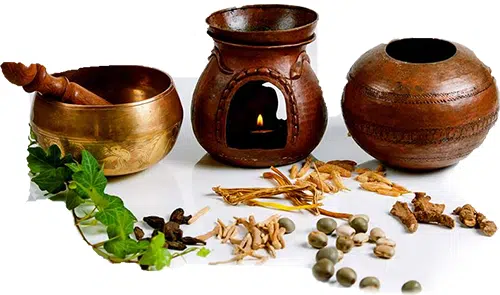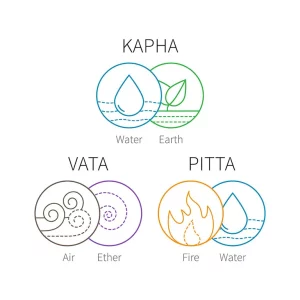
Ayurveda is considered to be the oldest healing science existing in the world. In Sanskrit, Ayurveda means “The Science of Life.” Ayurveda originated in India more than 5,000 years ago during Vedic time and is often called the “Mother of All Healing. The knowledge expanded further with laying down of fundamentals and concepts of Ayurveda and systematization in classical texts like Charaka Samhita, Sushruta Samhita and Ashtanga Sangraha around 400-200 BCE.
Ayurveda has eight major disciplines that are collectively known as Ashtanga Ayurveda, according to Sushruta and Vagbhata.
Ayurvedic concept of health goes beyond the simple absence of disease, which is prevalent in most ‘healthcare’ systems.
Charaka & Vaghbhata in Sutrasthana define health as:
“Samadosha, samagnischa samadhatumala kriyaha prasanna atmenindriya manaha swasthya ityabhidheeyate”
It defines doshas must be in equilibrium, the digestive fire must be in a balanced state and the tissues (dhatus) and malas (wastes) must work in a normal state. The sensory and motor organs, sense organs, mind, and soul must be also in a pleasant state. Such a person is, who is balanced in all those areas, is called a healthy person or Swastha.
Ayurveda emphasizes
“Swasthasya Swasthya Rakshanam Aturasya Roga Nivaranam” Charaka Samhita 0:26
Which means Ayurveda aims to rejuvenate and preserve the health of the healthy and alleviate the disease of the sick.
The preventive component emphasizes the need for a strict code of personal and social hygiene, the details of which depend upon individual, climatic, and environmental needs. The curative aspects of Ayurveda involve the use of herbal medicines, external applications, ayurvedic physiotherapy, and balance diet. Ayurveda’s preventive and therapeutic measures recognizes the necessity to maintain a harmony of body, mind and spirit.
Ayurveda describes a unique concept
“prakriti” (constitution), which is genetically determined at the time of conception. It categorises the humans into several subgroups based on phenotypic characters like appearance, temperament and habits. The concept is useful in predicting an individual’s susceptibility to a particular disease, prognosis of that illness, life style changes and selection of therapy.
Ayurveda believes that the entire universe is composed of five elements: Vayu (Air), Jala (Water), Aakash (Space or ether), Prithvi (Earth) and Teja (Fire). These five elements, referred to as “Pancha Mahabhoota” in Ayurveda, are believed to form the three basic humors of human body in varying combinations.

The three humors; Vata dosha, Pitta dosha and Kapha dosha are collectively called as “Tridoshas” and they control the basic physiological functions of the body.Vata dosha maintains the cellular transport, electrolyte balance, elimination of waste products and its effect is increased by dryness. Pitta dosha regulates the body temperature, optic nerve coordination and hunger and thirst management. Heat conditions of the body aggravate Pitta. Kapha dosha is increased due to sweet and fatty food and it provides lubrication to the joints for proper functioning. The catabolism of the body is believed to be governed by Vata, metabolism by Pitta and anabolism by Kapha.
The body is believed to be composed of seven types of tissues called as “Sapta Dhatus”. These seven tissues work in coordination with each for proper physiological functioning of the human body. The Rasa (Plasma) which is the first dhatu which contains nutrients & minerals from digested food and which nourishes & replenishes all the tissues and organs. The Rakta Dhatu resembles the blood and regulates the circulation of blood cells and provision of blood components to the body. The Mamsa Dhatu (Muscle tissue) provides supports in the form of skeletal muscles. Meda Dhathu (adipose fat) is the storage site for excess fat in the body. The Asthi Dhatu comprises the bones of the body and the Majja Dhatu is made up of the bone marrow and fluids required for the oleation of the bones and their functioning. The Shukra Dhatu is responsible for functions of the reproductive organs of the body.
Apart from the Doshas and the Dhatus, the other important factors considered in the doctrine of Ayurveda are the Tri Malas and Agni. Tri Malas are the three types of waste products formed in the body due to metabolic and digestive functions of the body. They comprise of the Mutra (urine), Purisa (faeces), and Sweda (sweat). As per the principles of Ayurveda the biological fire of the body for all the metabolic function is called as “Agni”. There are thirteen categories of Agni in a human body and the most important is the one responsible for digestive fire, called as Jatharagni.
“Swasthasya Swasthya Rakshanam Aturasya Roga Nivaranam” Charaka Samhita 30:26 Which means Ayurveda aims to rejuvenate and preserve the health of the healthy and alleviate the disease of the sick.
The preventive component emphasizes the need for a strict code of personal and social hygiene, the details of which depend upon individual, climatic, and environmental needs. The curative aspects of Ayurveda involve the use of herbal medicines, external applications, ayurvedic physiotherapy, and balance diet. Ayurveda’s preventive and therapeutic measures recognizes the necessity to maintain a harmony of body, mind and spirit.
Ayurveda describes a unique concept “prakriti” (constitution), which is genetically determined at the time of conception. It categorises the humans into several subgroups based on phenotypic characters like appearance, temperament and habits. The concept is useful in predicting an individual’s susceptibility to a particular disease, prognosis of that illness, life style changes and selection of therapy.
Ayurveda believes that the entire universe is composed of five elements: Vayu (Air), Jala (Water), Aakash (Space or ether), Prithvi (Earth) and Teja (Fire). These five elements, referred to as “Pancha Mahabhoota” in Ayurveda, are believed to form the three basic humors of human body in varying combinations. The three humors; Vata dosha, Pitta dosha and Kapha dosha are collectively called as “Tridoshas” and they control the basic physiological functions of the body.
Vata dosha maintains the cellular transport, electrolyte balance, elimination of waste products and its effect is increased by dryness. Pitta dosha regulates the body temperature, optic nerve coordination and hunger and thirst management. Heat conditions of the body aggravate Pitta. Kapha dosha is increased due to sweet and fatty food and it provides lubrication to the joints for proper functioning. The catabolism of the body is believed to be governed by Vata, metabolism by Pitta and anabolism by Kapha.
The body is believed to be composed of seven types of tissues called as “Sapta Dhatus”. These seven tissues work in coordination with each for proper physiological functioning of the human body. The Rasa (Plasma) which is the first dhatu which contains nutrients & minerals from digested food and which nourishes & replenishes all the tissues and organs. The Rakta Dhatu resembles the blood and regulates the circulation of blood cells and provision of blood components to the body. The Mamsa Dhatu (Muscle tissue) provides supports in the form of skeletal muscles. Meda Dhathu (adipose fat) is the storage site for excess fat in the body. The Asthi Dhatu comprises the bones of the body and the Majja Dhatu is made up of the bone marrow and fluids required for the oleation of the bones and their functioning. The Shukra Dhatu is responsible for functions of the reproductive organs of the body.
Apart from the Doshas and the Dhatus, the other important factors considered in the doctrine of Ayurveda are the Tri Malas and Agni. Tri Malas are the three types of waste products formed in the body due to metabolic and digestive functions of the body. They comprise of the Mutra (urine), Purisa (faeces), and Sweda (sweat). As per the principles of Ayurveda the biological fire of the body for all the metabolic function is called as “Agni”. There are thirteen categories of Agni in a human body and the most important is the one responsible for digestive fire, called as Jatharagni.
Health according to Ayurveda - Sama dosha samagnis ca sama dhatu mala kriyah prasannamendriya manah vastha ityabhidhiyate. Sushruta Samhita 15.38
One who is established in self, who has balanced doshas, balanced agni, properly formed dhatus, proper elimination of malas, well-functioning bodily processes and whose mind, soul and senses are happy is called a healthy person.